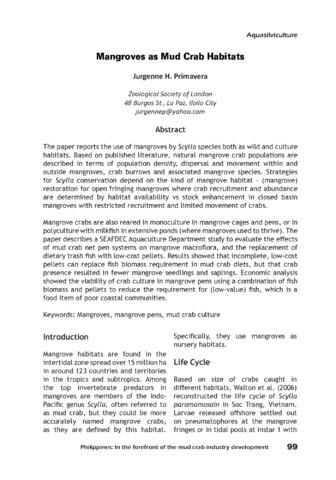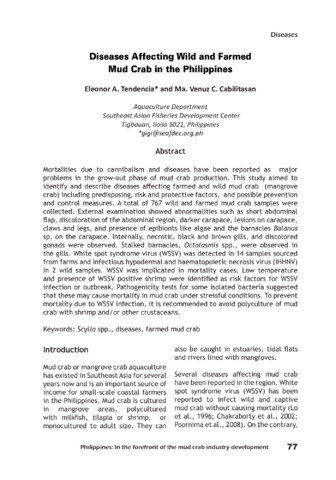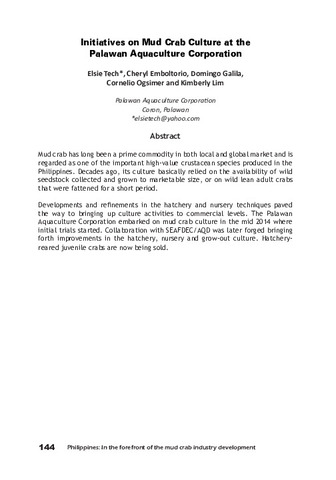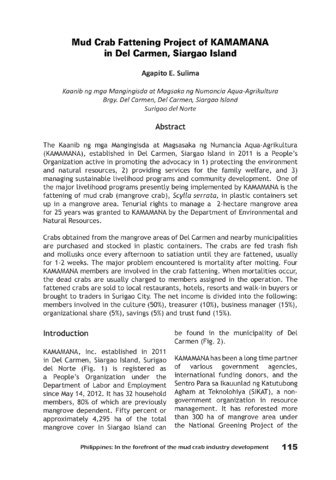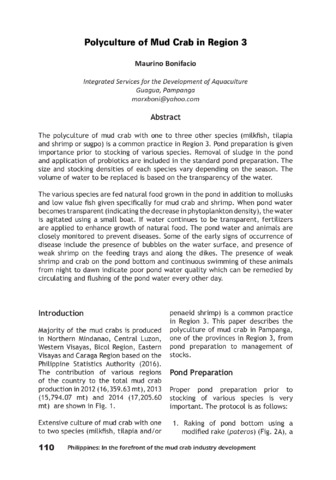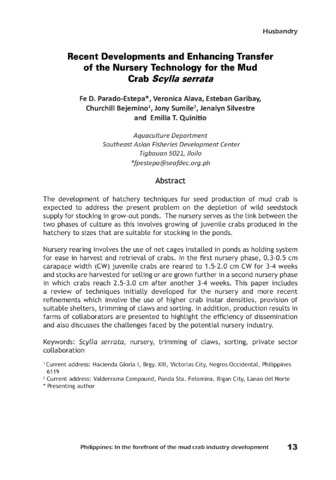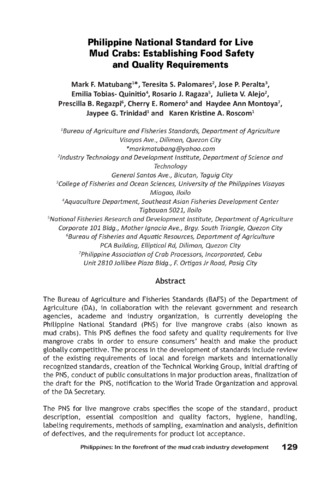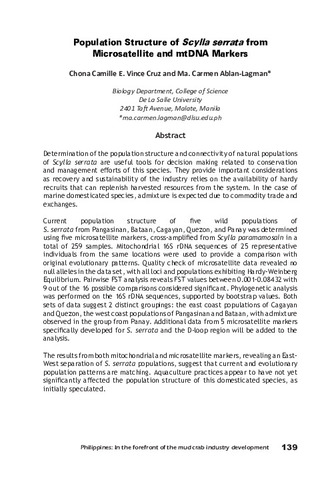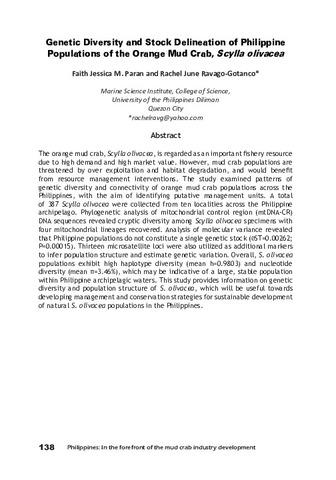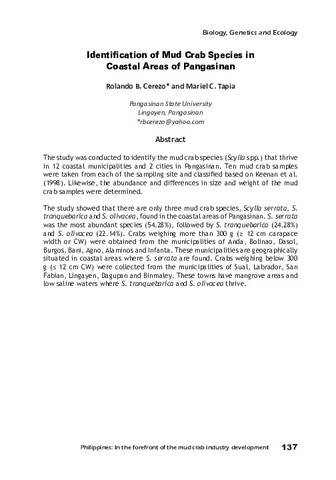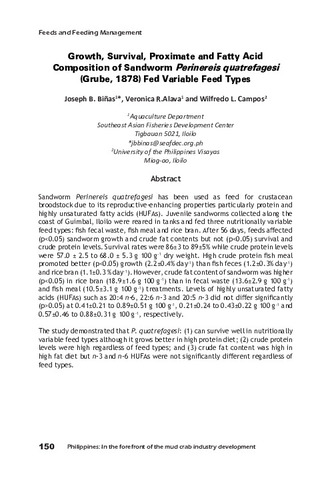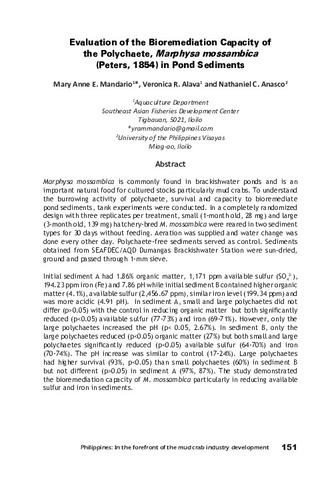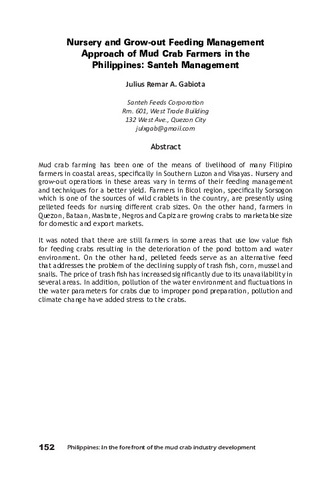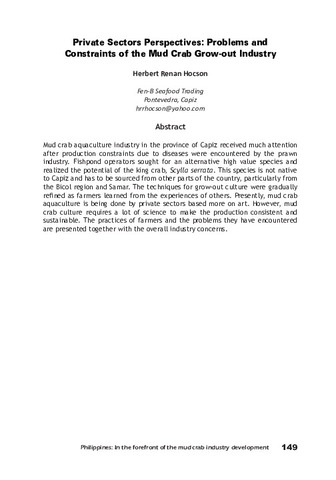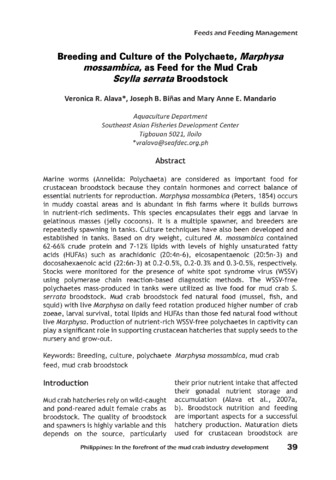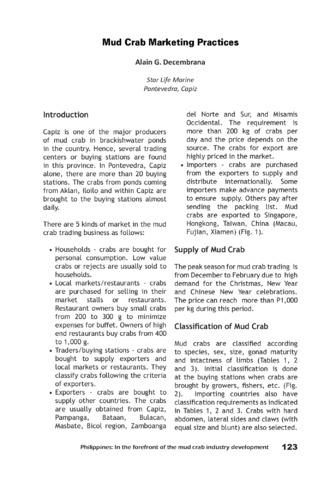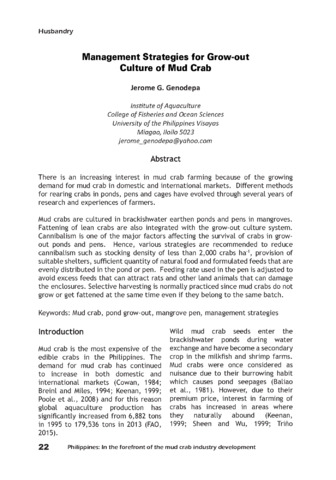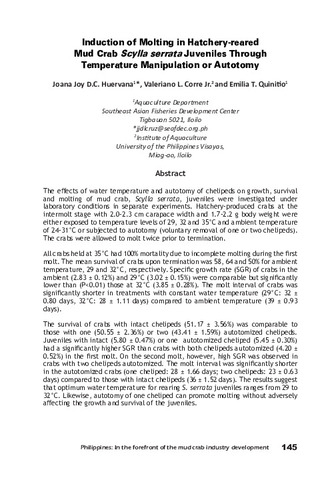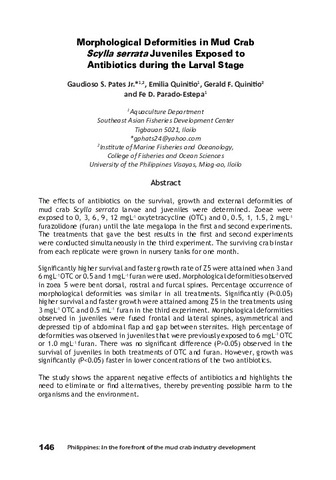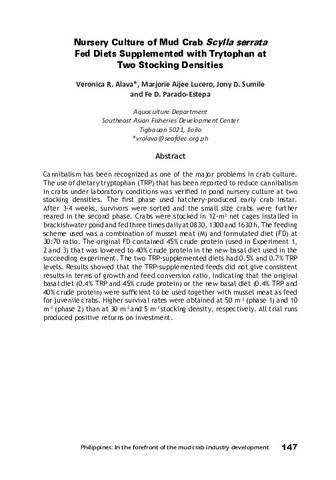การท่องเว็บ Philippines : In the forefront of the mud crab industry development ตามวันที่ออก
Now showing items 21-40 of 44
-
Mangroves as mud crab habitats
(Aquaculture Department, Southeast Asian Fisheries Development Center, 2017)The paper reports the use of mangroves by Scylla species both as wild and culture habitats. Based on published literature, natural mangrove crab populations are described in terms of population density, dispersal and ... -
Diseases affecting wild and farmed mud crab in the Philippines
(Aquaculture Department, Southeast Asian Fisheries Development Center, 2017)Mortalities due to cannibalism and diseases have been reported as major problems in the grow-out phase of mud crab production. This study aimed to identify and describe diseases affecting farmed and wild mud crab (mangrove ... -
Initiatives on mud crab culture at the Palawan Aquaculture Corporation
(Aquaculture Department, Southeast Asian Fisheries Development Center, 2017)Mud crab (Scylla spp) has long been a prime commodity in both local and global market and is regarded as one of the important high-value crustacean species produced in the Philippines. Decades ago, its culture basically ... -
Mud crab fattening project of KAMAMANA in Del Carmen, Siargao Island
(Aquaculture Department, Southeast Asian Fisheries Development Center, 2017)The Kaanib ng mga Mangingisda at Magsasaka ng Numancia Aqua-Agrikultura (KAMAMANA), established in Del Carmen, Siargao Island in 2011 is a People's Organization active in promoting the advocacy in 1) protecting the environment ... -
Polyculture of mud crab in Region 3
(Aquaculture Department, Southeast Asian Fisheries Development Center, 2017)The polyculture of mud crab with one to three other species (milkfish (Chanos chanos), tilapia (Oreochromis spp.) and shrimp or sugpo (Penaeus monodon)) is a common practice in Region 3. Pond preparation is given importance ... -
Recent developments and enhancing transfer of the nursery technology for the mud crab Scylla serrata
(Aquaculture Department, Southeast Asian Fisheries Development Center, 2017)The development of hatchery techniques for seed production of mud crab is expected to address the present problem on the depletion of wild seedstock supply for stocking in grow-out ponds. The nursery serves as the link ... -
Philippine National Standard for Live Mud Crabs: establishing food safety and quality requirements
(Aquaculture Department, Southeast Asian Fisheries Development Center, 2017)The Bureau of Agriculture and Fisheries Standards (BAFS) of the Department of Agriculture (DA), in collaboration with the relevant government and research agencies, academe and industry organization, is currently developing ... -
Population structure of Scylla serrata from microsatellite and mtDNA markers
(Aquaculture Department, Southeast Asian Fisheries Development Center, 2017)Determination of the population structure and connectivity of natural populations of Scylla serrata are useful tools for decision making related to conservation and management efforts of this species. They provide important ... -
Genetic diversity and stock delineation of Philippine populations of the orange mud crab, Scylla olivacea
(Aquaculture Department, Southeast Asian Fisheries Development Center, 2017)The orange mud crab, Scylla olivacea, is regarded as an important fishery resource due to high demand and high market value. However, mud crab populations are threatened by over exploitation and habitat degradation, and ... -
Identification of mud crab species in coastal areas of Pangasinan
(Aquaculture Department, Southeast Asian Fisheries Development Center, 2017)The study was conducted to identify the mud crab species (Scylla spp.) that thrive in 12 coastal municipalities and 2 cities in Pangasinan. Ten mud crab samples were taken from each of the sampling site and classified based ... -
Growth, survival, proximate and fatty acid composition of sandworm Perinereis quatrefagesi (Grube, 1878) fed variable feed types
(Aquaculture Department, Southeast Asian Fisheries Development Center, 2017)Sandworm Perinereis quatrefagesi has been used as feed for crustacean broodstock due to its reproductive-enhancing properties particularly protein and highly unsaturated fatty acids (HUFAs). Juvenile sandworms collected ... -
Evaluation of the bioremediation capacity of the polychaete, Marphysa mossambica (Peters, 1854) in pond sediments
(Aquaculture Department, Southeast Asian Fisheries Development Center, 2017)Marphysa mossambica is commonly found in brackishwater ponds and is an important natural food for cultured stocks particularly mud crabs. To understand the burrowing activity of polychaete, survival and capacity to ... -
Nursery and grow-out feeding management of mud crab farmers in the Philippines: Santeh experience
(Aquaculture Department, Southeast Asian Fisheries Development Center, 2017)Mud crab (Scylla serrata) farming has been one of the means of livelihood of many Filipino farmers in coastal areas, specifically in Southern Luzon and Visayas. Nursery and grow-out operations in these areas vary in terms ... -
Private sectors perspectives: Problems and constraints of the mud crab grow-out industry
(Aquaculture Department, Southeast Asian Fisheries Development Center, 2017)Mud crab aquaculture industry in the province of Capiz received much attention after production constraints due to diseases were encountered by the prawn industry. Fishpond operators sought for an alternative high value ... -
Breeding and culture of the polychaete, Marphysa mossambica, as feed for the mud crab
(Aquaculture Department, Southeast Asian Fisheries Development Center, 2017)Marine worms (Annelida: Polychaeta) are considered as important food for crustacean broodstock because they contain hormones and correct balance of essential nutrients for reproduction. Marphysa mossambica (Peters, 1854) ... -
Mud crab marketing practices
(Aquaculture Department, Southeast Asian Fisheries Development Center, 2017)Presented in the article is the mud crab (Scylla spp.) marketing practices in the province of Capiz. It is one of the major producers of mud crab in brackishwater ponds in the country. Hence, several trading centers or ... -
Management strategies for grow-out culture of mud crab
(Aquaculture Department, Southeast Asian Fisheries Development Center, 2017)There is an increasing interest in mud crab farming because of the growing demand for mud crab in domestic and international markets. Different methods for rearing crabs in ponds, pens and cages have evolved through several ... -
Induction of molting in hatchery-reared mud crab Scylla serrata juveniles through temperature manipulation or autotomy
(Aquaculture Department, Southeast Asian Fisheries Development Center, 2017)The effects of water temperature and autotomy of chelipeds on growth, survival and molting of mud crab, Scylla serrata, juveniles were investigated under laboratory conditions in separate experiments. Hatchery-produced ... -
Morphological deformities in mud crab Scylla serrata juveniles exposed to antibiotics during the larval stage
(Aquaculture Department, Southeast Asian Fisheries Development Center, 2017)The effects of antibiotics on the survival, growth and external deformities of mud crab Scylla serrata larvae and juveniles were determined. Zoeae were exposed to 0, 3, 6, 9, 12 mgL-1 oxytetracycline (OTC) and ... -
Nursery culture of mud crab Scylla serrata fed diets supplemented with trytophan at two stocking densities
(Aquaculture Department, Southeast Asian Fisheries Development Center, 2017)Cannibalism has been recognized as one of the major problems in crab culture. The use of dietary tryptophan (TRP) that has been reported to reduce cannibalism in crabs under laboratory conditions was verified in pond nursery ...

